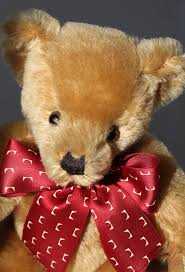
Merrythought Teddies
Merrythought Ltd. was the brainchild of two men who had been partners since 1919 when they had opened a small spinning mill in Yorkshire, England to make mohair yarn: Gordon Holmes and George Laxton. In 1930 they decided to use their yarn to make their own toys, including teddy bears. And so Merrythought was born, rather a latecomer to the world of soft teddy bears
The newly formed company set up shop in Ironbridge, Shropshire, renting property from Coalbrookdale Co. and almost immediately started production.
In setting up their company, Holmes and Laxton brought in A.C. Janisch, then head of sales at J. K. Farnell, to be Merrythought’s sales director. They also lured C. J. Rendle, the head of production, away from Chad Valley. Rendle brought some of his staff with him, including Florence Attwood. Attwood would go on to design many of Merrythought’s toys until her death in 1949, including Greyfriars Bobby and MGM’s Tom and Jerry in addition to well-known teddy bears; some of her original patterns are still being used. A deaf-mute who had attended the Deaf and Dumb School in Manchester with Rendle’s daughter, Attwood was very talented and designed all 32 of the toys in Merrythought’s first catalogue.
So it is not surprising that early teddy bears from Merrythought resembled those of their competitors at Chad Valley and J. K. Farnell. Nor is it surprising that Merrythought hit the ground running, publishing its first catalogue in 1931 when it was just one year old. Included in that first catalogue were Merrythought’s first teddy bears, Magnet Bear and Merrythought Bear.
The first Merrythought bears had many of the characteristics of British bears of the 1930’s – short legs and rounded arms with spoon-shaped paws. Additionally, the Merrythought Bear line had the Chad Valley look of large flat ears and a shaved muzzle, while their webbed paws had the J. K. Farnell look. The bears’ noses and mouths, however, were different – vertical stitching for the mouth with upturned stitches at each end above a Y-shaped mouth gave the effect of the bear laughing.
One of the early successes was a sitting bear cub named Bingie. He had big floppy ears, a broad brow, and oversized feet that endeared him to his fans. His line (1931-1938) was expanded until there were seven sizes including two small bears, plus editions in different costumes.
Merrythought was going gangbusters until 1939 and the onset of World War II. At that time their facilities were taken over by the British Admiralty for the war effort, and Merrythought switched to another site to make fabric items for the war.
In 1946, after the war was over, Merrythought resumed making toys at their original location in Coalbrookdale. And though their factory was flooded by the Severn River later that year, they soon recovered.
In the 1950’s Merrythought, along with other toy companies, began making novelty toys. In 1952 they made a red, white and blue bear to celebrate the coronation of Queen Elizabeth II and in 1957 gave birth to Cheeky. This new bear had a very round head with floppy ears on the side and a wide mischievous smile. He also had a small bell in one of his ears which rang when the bear moved. Cheeky was immediately popular, a popularity he keeps today, especially among collectors.
Merrythought also followed the trends in which bears were tied in with famous characters, whether in comic books or real life. One of the most famous bears they made was Mr. Woppit, a little stand-up bear in a red felt jacket and blue fixed shoes who, with an “h” added to his name (Whoppit), became the mascot of Donald Campbell, race car and speedboat driver. After Campbell’s boat crashed in 1967 trying to set another world record, Mr. Whoppit somehow managed to float to the surface and be rescued although his master’s boat, the Bluebird, wasn’t found until 2001.
Mr. Whoppit’s career, however, continued with Campbell’s daughter Gina who broke several women’s speedboat records with Mr. Whoppit at her side. Today he is semi-retired, working with Gina to promote water safety in New Zealand.
Merrythought has continued to make teddy bears in spite of market downturns. They have survived whereas their British competitors have not. And they still use traditional methods for making the bears, including the use of mohair. However, changes were made in the 2000’s largely due to cheap teddy bears produced outside the UK. For a while, from 2007-2010 they used an outside company for actual production of the bears, but the arrangement didn’t work out so in 2010 Merrythought brought production back in house at Ironbridge.
Today all Merrythought teddy bears are handmade in the UK. And they continue to delight their fans far and near. The depreciation of the British pound against the Japanese yen since 2008 has helped exports to Japan, and the depreciation of the pound in general has helped with exports to many countries including, interestingly enough, continental Europe. In addition the Brexit vote has shown promise of more exports, especially to the United States. And they invite visitors to the Shropshire region of England to come visit their shop and museum, opened in 1988, while they’re there.
